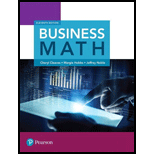
Business Math (11th Edition)
11th Edition
ISBN: 9780134496436
Author: Cheryl Cleaves, Margie Hobbs, Jeffrey Noble
Publisher: PEARSON
expand_more
expand_more
format_list_bulleted
Concept explainers
Question
Chapter 1.1, Problem 12SE
To determine
The number which is described in words “Three hundred million, seven hundred sixty thousand, and five hundred twelve”.
Expert Solution & Answer
Want to see the full answer?
Check out a sample textbook solution
Students have asked these similar questions
Does the series converge or diverge
Does the series converge or diverge
Diverge or conver
Chapter 1 Solutions
Business Math (11th Edition)
Ch. 1.1 - Prob. 1-1SCCh. 1.1 - Prob. 1-2SCCh. 1.1 - Prob. 1-3SCCh. 1.1 - Prob. 1-4SCCh. 1.1 - Prob. 2-1SCCh. 1.1 - Prob. 2-2SCCh. 1.1 - Prob. 2-3SCCh. 1.1 - Prob. 2-4SCCh. 1.1 - Prob. 3-1SCCh. 1.1 - Prob. 3-2SC
Ch. 1.1 - Prob. 3-3SCCh. 1.1 - Prob. 3-4SCCh. 1.1 - Prob. 3-5SCCh. 1.1 - Prob. 3-6SCCh. 1.1 - Prob. 4-1SCCh. 1.1 - Prob. 4-2SCCh. 1.1 - Prob. 4-3SCCh. 1.1 - Prob. 4-4SCCh. 1.1 - Prob. 1SECh. 1.1 - Prob. 2SECh. 1.1 - Prob. 3SECh. 1.1 - Prob. 4SECh. 1.1 - Prob. 5SECh. 1.1 - Prob. 6SECh. 1.1 - Prob. 7SECh. 1.1 - Prob. 8SECh. 1.1 - Prob. 9SECh. 1.1 - Prob. 10SECh. 1.1 - Prob. 11SECh. 1.1 - Prob. 12SECh. 1.1 - Prob. 13SECh. 1.1 - Prob. 14SECh. 1.1 - Prob. 15SECh. 1.1 - Prob. 16SECh. 1.1 - Prob. 17SECh. 1.1 - Prob. 18SECh. 1.1 - Prob. 19SECh. 1.1 - Prob. 20SECh. 1.1 - Prob. 21SECh. 1.1 - Prob. 22SECh. 1.1 - Prob. 23SECh. 1.1 - Prob. 24SECh. 1.1 - Prob. 25SECh. 1.1 - Prob. 26SECh. 1.2 - Prob. 1-1SCCh. 1.2 - Prob. 1-2SCCh. 1.2 - Prob. 1-3SCCh. 1.2 - Prob. 1-4SCCh. 1.2 - Prob. 1-5SCCh. 1.2 - Prob. 1-6SCCh. 1.2 - Prob. 1-7SCCh. 1.2 - Prob. 1-8SCCh. 1.2 - Prob. 1-9SCCh. 1.2 - Prob. 1-10SCCh. 1.2 - Prob. 1-11SCCh. 1.2 - Prob. 1-12SCCh. 1.2 - Prob. 2-1SCCh. 1.2 - Prob. 2-2SCCh. 1.2 - Prob. 2-3SCCh. 1.2 - Prob. 2-4SCCh. 1.2 - Prob. 2-5SCCh. 1.2 - Prob. 2-6SCCh. 1.2 - Prob. 3-1SCCh. 1.2 - Prob. 3-2SCCh. 1.2 - Prob. 3-3SCCh. 1.2 - Prob. 3-4SCCh. 1.2 - Prob. 3-5SCCh. 1.2 - Prob. 3-6SCCh. 1.2 - Prob. 3-7SCCh. 1.2 - Prob. 3-8SCCh. 1.2 - Prob. 3-9SCCh. 1.2 - Prob. 3-10SCCh. 1.2 - Prob. 4-1SCCh. 1.2 - Prob. 4-2SCCh. 1.2 - Prob. 4-3SCCh. 1.2 - Prob. 4-4SCCh. 1.2 - Prob. 4-5SCCh. 1.2 - Prob. 4-6SCCh. 1.2 - Prob. 4-7SCCh. 1.2 - Prob. 4-8SCCh. 1.2 - Prob. 4-9SCCh. 1.2 - Prob. 4-10SCCh. 1.2 - Prob. 5-1SCCh. 1.2 - Prob. 5-2SCCh. 1.2 - Prob. 5-3SCCh. 1.2 - Prob. 5-4SCCh. 1.2 - Prob. 1SECh. 1.2 - Prob. 2SECh. 1.2 - Prob. 3SECh. 1.2 - Prob. 4SECh. 1.2 - Prob. 5SECh. 1.2 - Prob. 6SECh. 1.2 - Prob. 7SECh. 1.2 - Prob. 8SECh. 1.2 - Prob. 9SECh. 1.2 - Prob. 10SECh. 1.2 - Prob. 11SECh. 1.2 - Prob. 12SECh. 1.2 - Prob. 13SECh. 1.2 - Prob. 14SECh. 1.2 - Prob. 15SECh. 1.2 - Prob. 16SECh. 1.2 - Prob. 17SECh. 1.2 - Prob. 18SECh. 1.2 - Prob. 19SECh. 1.2 - Prob. 20SECh. 1.2 - Prob. 21SECh. 1.2 - Prob. 22SECh. 1.2 - Prob. 23SECh. 1.2 - Prob. 24SECh. 1.2 - Prob. 25SECh. 1.2 - Prob. 26SECh. 1.2 - Prob. 27SECh. 1.2 - Prob. 28SECh. 1.2 - Prob. 29SECh. 1.2 - Prob. 30SECh. 1.2 - Prob. 31SECh. 1.2 - Prob. 32SECh. 1.2 - Prob. 33SECh. 1.2 - Prob. 34SECh. 1.2 - Prob. 35SECh. 1.2 - Prob. 36SECh. 1.2 - Prob. 37SECh. 1.2 - Prob. 38SECh. 1.2 - Prob. 39SECh. 1.2 - Prob. 40SECh. 1.2 - Prob. 41SECh. 1.2 - Prob. 42SECh. 1.2 - Prob. 43SECh. 1.2 - Prob. 44SECh. 1.2 - Prob. 45SECh. 1.2 - Prob. 46SECh. 1.2 - Prob. 47SECh. 1.2 - Prob. 48SECh. 1.2 - Prob. 49SECh. 1.2 - Prob. 50SECh. 1.2 - Prob. 51SECh. 1.2 - Prob. 52SECh. 1.2 - Prob. 53SECh. 1.2 - Prob. 54SECh. 1.2 - Prob. 55SECh. 1.2 - Prob. 56SECh. 1 - Prob. 1ESCh. 1 - Prob. 2ESCh. 1 - Prob. 3ESCh. 1 - Prob. 4ESCh. 1 - Prob. 5ESCh. 1 - Prob. 6ESCh. 1 - Prob. 7ESCh. 1 - Prob. 8ESCh. 1 - Prob. 9ESCh. 1 - Prob. 10ESCh. 1 - Prob. 11ESCh. 1 - Prob. 12ESCh. 1 - Prob. 13ESCh. 1 - Prob. 14ESCh. 1 - Prob. 15ESCh. 1 - Prob. 16ESCh. 1 - Prob. 17ESCh. 1 - Prob. 18ESCh. 1 - Prob. 19ESCh. 1 - Prob. 20ESCh. 1 - Prob. 21ESCh. 1 - Prob. 22ESCh. 1 - Prob. 23ESCh. 1 - Prob. 24ESCh. 1 - Prob. 25ESCh. 1 - Prob. 26ESCh. 1 - Prob. 27ESCh. 1 - Prob. 28ESCh. 1 - Prob. 29ESCh. 1 - Prob. 30ESCh. 1 - Prob. 31ESCh. 1 - Prob. 32ESCh. 1 - Prob. 33ESCh. 1 - Prob. 34ESCh. 1 - Prob. 35ESCh. 1 - Prob. 36ESCh. 1 - Prob. 37ESCh. 1 - Prob. 38ESCh. 1 - Prob. 39ESCh. 1 - Prob. 40ESCh. 1 - Prob. 41ESCh. 1 - Prob. 42ESCh. 1 - Prob. 43ESCh. 1 - Prob. 44ESCh. 1 - Prob. 45ESCh. 1 - Prob. 46ESCh. 1 - Prob. 47ESCh. 1 - Prob. 48ESCh. 1 - Prob. 49ESCh. 1 - Prob. 50ESCh. 1 - Prob. 51ESCh. 1 - Prob. 52ESCh. 1 - Prob. 53ESCh. 1 - Prob. 54ESCh. 1 - Prob. 55ESCh. 1 - Prob. 56ESCh. 1 - Prob. 57ESCh. 1 - Prob. 58ESCh. 1 - Prob. 59ESCh. 1 - Prob. 60ESCh. 1 - Prob. 61ESCh. 1 - Prob. 62ESCh. 1 - Prob. 63ESCh. 1 - Prob. 64ESCh. 1 - Prob. 65ESCh. 1 - Prob. 66ESCh. 1 - Prob. 67ESCh. 1 - Prob. 68ESCh. 1 - Prob. 69ESCh. 1 - Prob. 70ESCh. 1 - Prob. 71ESCh. 1 - Prob. 72ESCh. 1 - Prob. 73ESCh. 1 - Prob. 74ESCh. 1 - Prob. 75ESCh. 1 - Prob. 76ESCh. 1 - Prob. 77ESCh. 1 - Prob. 78ESCh. 1 - Prob. 79ESCh. 1 - Prob. 80ESCh. 1 - Prob. 81ESCh. 1 - Prob. 82ESCh. 1 - Prob. 83ESCh. 1 - Prob. 84ESCh. 1 - Prob. 85ESCh. 1 - Prob. 86ESCh. 1 - Prob. 87ESCh. 1 - Prob. 88ESCh. 1 - Prob. 89ESCh. 1 - Prob. 1PTCh. 1 - Prob. 2PTCh. 1 - Prob. 3PTCh. 1 - Prob. 4PTCh. 1 - Prob. 5PTCh. 1 - Prob. 6PTCh. 1 - Prob. 7PTCh. 1 - Prob. 8PTCh. 1 - Prob. 9PTCh. 1 - Prob. 10PTCh. 1 - Prob. 11PTCh. 1 - Prob. 12PTCh. 1 - Prob. 13PTCh. 1 - Prob. 14PTCh. 1 - Prob. 15PTCh. 1 - Prob. 16PTCh. 1 - Prob. 17PTCh. 1 - Prob. 18PTCh. 1 - Prob. 19PTCh. 1 - Prob. 20PTCh. 1 - Prob. 21PTCh. 1 - Prob. 22PTCh. 1 - Prob. 23PTCh. 1 - Prob. 24PTCh. 1 - Prob. 25PTCh. 1 - Prob. 26PTCh. 1 - Prob. 27PTCh. 1 - Prob. 28PTCh. 1 - Prob. 29PTCh. 1 - Prob. 30PTCh. 1 - Prob. 31PTCh. 1 - Prob. 32PTCh. 1 - Prob. 1CTCh. 1 - Prob. 2CTCh. 1 - Prob. 3CTCh. 1 - Prob. 4CTCh. 1 - Prob. 5CTCh. 1 - Prob. 6CTCh. 1 - Prob. 7CTCh. 1 - Prob. 8CTCh. 1 - Prob. 9CTCh. 1 - Prob. 10CTCh. 1 - Prob. 11CTCh. 1 - Prob. 12CTCh. 1 - Prob. 1CPCh. 1 - Prob. 2CPCh. 1 - Prob. 1CS1Ch. 1 - Prob. 2CS1Ch. 1 - Prob. 3CS1Ch. 1 - Prob. 1CS2Ch. 1 - Prob. 2CS2Ch. 1 - Prob. 3CS2Ch. 1 - Prob. 1CS3Ch. 1 - Prob. 2CS3Ch. 1 - Prob. 3CS3Ch. 1 - Prob. 4CS3Ch. 1 - Prob. 5CS3
Knowledge Booster
Learn more about
Need a deep-dive on the concept behind this application? Look no further. Learn more about this topic, subject and related others by exploring similar questions and additional content below.Similar questions
- Can you help explain what I did based on partial fractions decomposition?arrow_forwardFind the surface area of the regular pyramid. yd2arrow_forwardSuppose that a particle moves along a straight line with velocity v (t) = 62t, where 0 < t <3 (v(t) in meters per second, t in seconds). Find the displacement d (t) at time t and the displacement up to t = 3. d(t) ds = ["v (s) da = { The displacement up to t = 3 is d(3)- meters.arrow_forward
- Let f (x) = x², a 3, and b = = 4. Answer exactly. a. Find the average value fave of f between a and b. fave b. Find a point c where f (c) = fave. Enter only one of the possible values for c. c=arrow_forwardThe following data represent total ventilation measured in liters of air per minute per square meter of body area for two independent (and randomly chosen) samples. Analyze these data using the appropriate non-parametric hypothesis testarrow_forwardeach column represents before & after measurements on the same individual. Analyze with the appropriate non-parametric hypothesis test for a paired design.arrow_forward
- Should you be confident in applying your regression equation to estimate the heart rate of a python at 35°C? Why or why not?arrow_forwardGiven your fitted regression line, what would be the residual for snake #5 (10 C)?arrow_forwardCalculate the 95% confidence interval around your estimate of r using Fisher’s z-transformation. In your final answer, make sure to back-transform to the original units.arrow_forward
arrow_back_ios
SEE MORE QUESTIONS
arrow_forward_ios
Recommended textbooks for you
 Holt Mcdougal Larson Pre-algebra: Student Edition...AlgebraISBN:9780547587776Author:HOLT MCDOUGALPublisher:HOLT MCDOUGAL
Holt Mcdougal Larson Pre-algebra: Student Edition...AlgebraISBN:9780547587776Author:HOLT MCDOUGALPublisher:HOLT MCDOUGAL Algebra: Structure And Method, Book 1AlgebraISBN:9780395977224Author:Richard G. Brown, Mary P. Dolciani, Robert H. Sorgenfrey, William L. ColePublisher:McDougal Littell
Algebra: Structure And Method, Book 1AlgebraISBN:9780395977224Author:Richard G. Brown, Mary P. Dolciani, Robert H. Sorgenfrey, William L. ColePublisher:McDougal Littell Elementary AlgebraAlgebraISBN:9780998625713Author:Lynn Marecek, MaryAnne Anthony-SmithPublisher:OpenStax - Rice University
Elementary AlgebraAlgebraISBN:9780998625713Author:Lynn Marecek, MaryAnne Anthony-SmithPublisher:OpenStax - Rice University Mathematics For Machine TechnologyAdvanced MathISBN:9781337798310Author:Peterson, John.Publisher:Cengage Learning,
Mathematics For Machine TechnologyAdvanced MathISBN:9781337798310Author:Peterson, John.Publisher:Cengage Learning, Functions and Change: A Modeling Approach to Coll...AlgebraISBN:9781337111348Author:Bruce Crauder, Benny Evans, Alan NoellPublisher:Cengage Learning
Functions and Change: A Modeling Approach to Coll...AlgebraISBN:9781337111348Author:Bruce Crauder, Benny Evans, Alan NoellPublisher:Cengage Learning

Holt Mcdougal Larson Pre-algebra: Student Edition...
Algebra
ISBN:9780547587776
Author:HOLT MCDOUGAL
Publisher:HOLT MCDOUGAL

Algebra: Structure And Method, Book 1
Algebra
ISBN:9780395977224
Author:Richard G. Brown, Mary P. Dolciani, Robert H. Sorgenfrey, William L. Cole
Publisher:McDougal Littell

Elementary Algebra
Algebra
ISBN:9780998625713
Author:Lynn Marecek, MaryAnne Anthony-Smith
Publisher:OpenStax - Rice University

Mathematics For Machine Technology
Advanced Math
ISBN:9781337798310
Author:Peterson, John.
Publisher:Cengage Learning,

Functions and Change: A Modeling Approach to Coll...
Algebra
ISBN:9781337111348
Author:Bruce Crauder, Benny Evans, Alan Noell
Publisher:Cengage Learning
Statistics 4.1 Introduction to Inferential Statistics; Author: Dr. Jack L. Jackson II;https://www.youtube.com/watch?v=QLo4TEvBvK4;License: Standard YouTube License, CC-BY